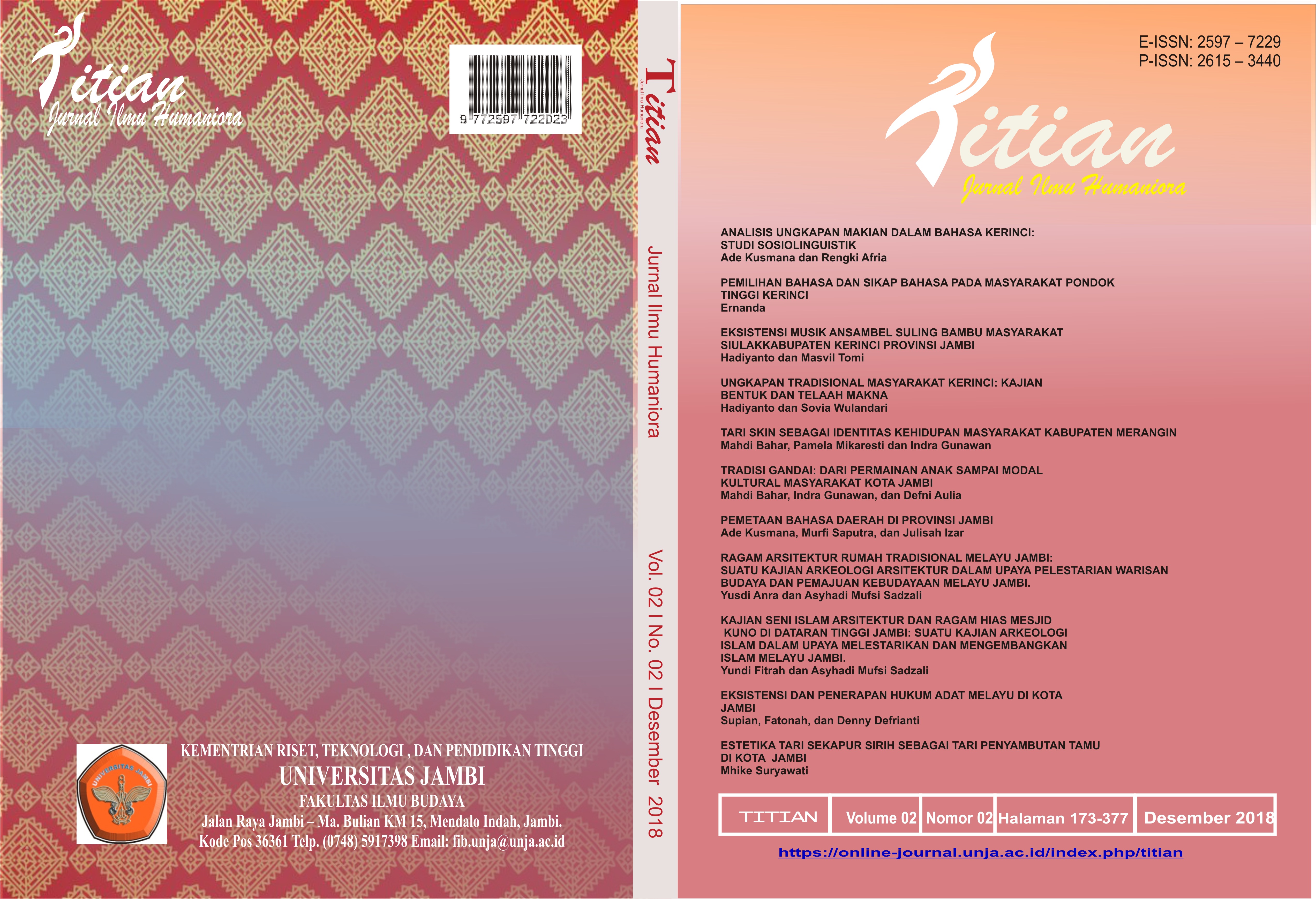PEMILIHAN BAHASA DAN SIKAP BAHASA PADA MASYARAKAT PONDOK TINGGI KERINCI
DOI:
https://doi.org/10.22437/titian.v2i02.6087Keywords:
language choice, language attitudes, Pondok Tinggi, KerinciAbstract
This study aims at investigating language choice and language attitudes among the Pondok Tinggi community, in the Kerinci region, Indonesia. The subjects of this study were two groups of informants consisting of 10 members of the older generation and 10 of the younger. A sociolinguistic questionnaire was used to explore the language choice of the informants and an interview was conducted to examine attitudes towards the languages they speak. The results of this study show that the older generation uses Pondok Tinggi in various domains and for different functions while most of the younger generation has started to leave it behind and instead uses the dominant languages, like Indonesian and Minangkabau. The language attitude of both generations towards Indonesian is very positive. It is considered to have economic value and is useful for the future. The old generation shows a neutral attitude towards Minangkabau. The attitude towards Minangkabau tends to be generally positive among the younger generation. It is considered as a social language. The younger generation expressed a negative attitude towards Pondok Tinggi, considering it unsophisticated and of no economic value. Although the older generation uses Pondok Tinggi in daily life, their attitude towards it is not positive. Parents do not transmit Pondok Tinggi to children in the home domain. When intergenerational transmission breaks down, there will be a sharp decline in the use of Pondok Tinggi. Sooner or later it will lose its speakers. Without speakers, it will die.
Downloads
References
Baker, C. (1992). Attitudes and Language. Clevedon, Avon: Multilingual Matters.
Cavanaugh, J. R. (2013). Language ideologies and language attitudes: A linguistic anthropological perspective. In P. Auer., J. C. Reina, and G. Kaufmann (Eds.), Language variation: European perspectives IV (pp.45-56). Amsterdam: John Benjamin Publishing Company.
Coronel-Molina, S. M. (2009). Definitions and critical literature review of language attitude, language choice and language shift: Samples of language attitude surveys. Indiana University, Bloomington. Unpublished manuscript.
Crystal, D. (1997). A dictionary of linguistics and phonetics (4th Ed). Oxford, UK: Blackwell.
Crystal, D. (2000). Language Death. Cambridge: University Press.
Davies, W. V. (1995). Linguistic variation and language attitudes in Mannheim-Neckarau. Stuttgart: Franz Steiner Verlag.
Duan, L. (2004). A sociolinguistic study of language use and language attitudes among the Bai people in Jianchuan country, China. Presented to the graduate school of Payap University for the degree of Master of Arts in linguistics. Payap University, Ching Mai, Thailand.
Ernanda. (2011). On the Loss of the Phrasal Alternation in the Pondok Tinggi Dialect of Kerinci: A stochastic Optimality Theory Approach. Radboud University Nijmegen. The Netherlands. [Unpublished Master thesis]
Ernanda. (2015). Phrasal alternation in the Pondok Tinggi dialect of Kerinci: An intergenerational analysis. Wacana.Vol.16, No.2, pp.355-382.
Ernanda. (2017). Phrasal Alternation in Kerinci. Leiden University Centre for Linguistics. LOT: Utrecht, The Netherlands.
Fasold, R. (1987). The sociolinguistics of society. Oxford, UK: Blackwell.
Fishman, J. (1965). Who speaks what language to whom and when? La Linguistique. Vol.1(2). pp.67-88.
Garrett, P., Coupland, N., & Williams A. (2003). Investigating language attitudes: Social meanings of dialect, ethnicity, and performance. Cardiff: University of Wales Press.
Giles, H., Bourhis, R.Y., & Taylor, D. M. (1977). Towards a theory of language in ethnic group relations. In H. Giles (Ed.), Language, ethnicity and intergroup relations. London: Academic Press.
Giles, H., & St. Clair, R. N. (Eds.). (1979). Language and social psychology. Language in Society 1. Baltimore: University Park Press.
Gravel, L. (1979). A sociolinguistic investigation of multilingualism in Morocco. Columbia University Teachers College. [Unpublished Ph.D. Dissertation]
Herman, S. N. (1961). Explorations in the social psychology of language choice. Human relations, Vol. 14 (2). pp.149-164.
Jenkin, M. (2014). What makes a language attractive – its sound, national identity or familiarity? The Guardian,. Retrieved from https://www.theguardian.com/education/2014/jul/17/what-makes-a-language-attractive.
Kerswill, P. (2008). Koineization and accommodation. In J.K. Chambers., P. Trudgill, and N. Schilling-Estes. The handbook of language variation and change. Oxford: Blackwell Publishing. pp. 669–702.
Richards, J. C., Platt, J., & Platt, H. (1992). Longman dictionary of language teaching and applied linguistics (2nd Ed). Essex, UK: Longman Publishers.
Sridhar, K.K. (1996). Societal multilingualism. In S.L. McKay, and N.H. Hornberger, (Eds.), Sociolinguistics and language teaching (pp.47-70). Cambridge: Cambridge University Press.
Stevens, P. S. (1974). French and Arabic bilingualism in North Africa with special reference to Tunisia: A study of language attitudes and language use patterns. Georgetown Universty. [Unpublished PhD Dissertation].
Tessler, M. A. (1969). The nature of modernity in a transitional society: The case of Tunisia. Northwestern University. [Unpublished PhD Dissertation].
Trudgill, P. (1986). Dialects in contact. New York: Basil Blackwell.
Tuwakham, M. (2005). Language vitality and language attitude among the young people in Lamphun Province: A sociolinguistic study. Payap University, Thailand. [Unpublished MA Thesis]
Usman, A. H. (1988) Fonologi dan Morfologi Bahasa Kerinci Dialek Sungai Penuh. Jakarta: Universitas Indonesia Fakultas Pascasarjana. [Unpublished Ph.D Dissertation].
Downloads
Published
Versions
- 2018-12-31 (1)
- 2018-12-31 (1)































